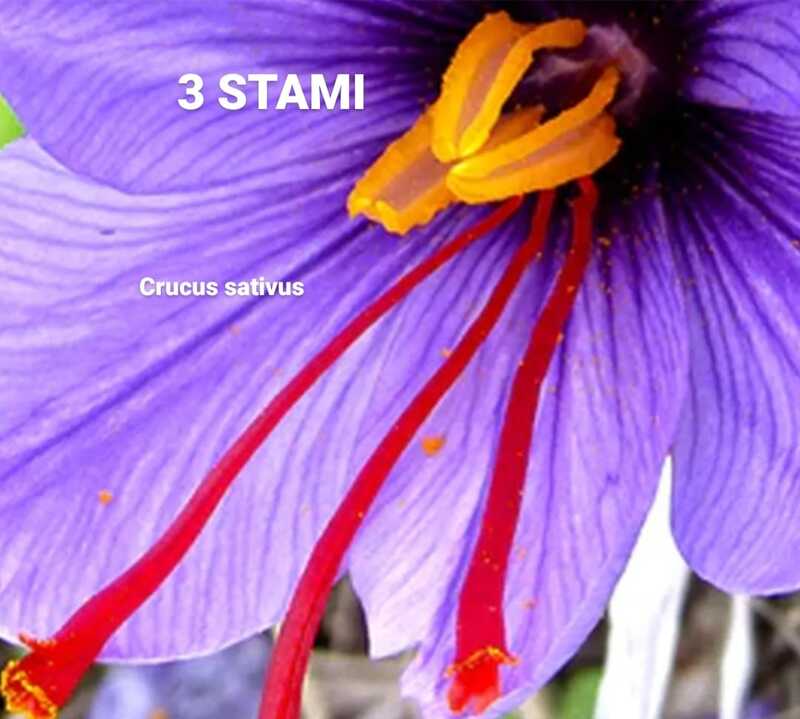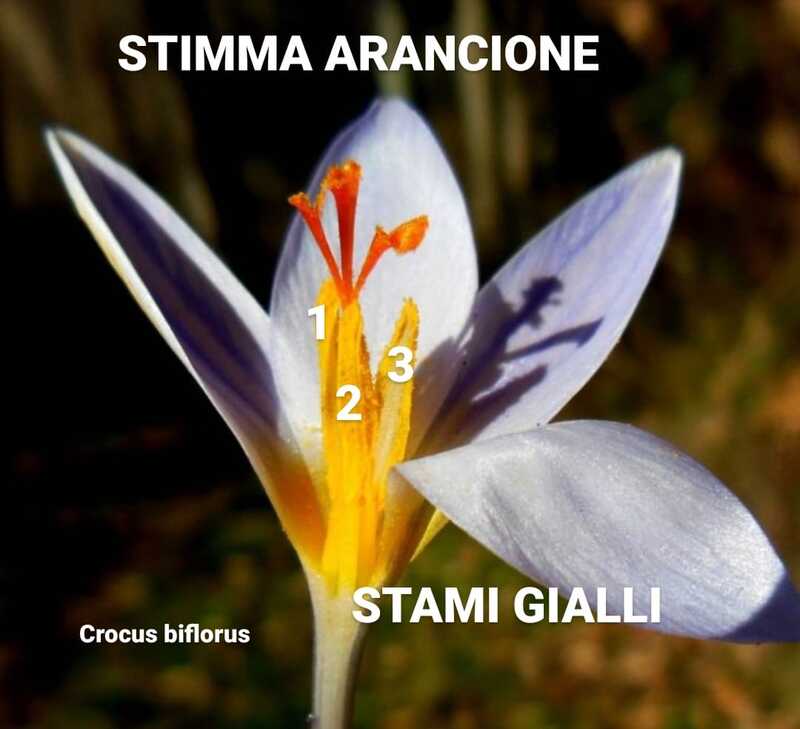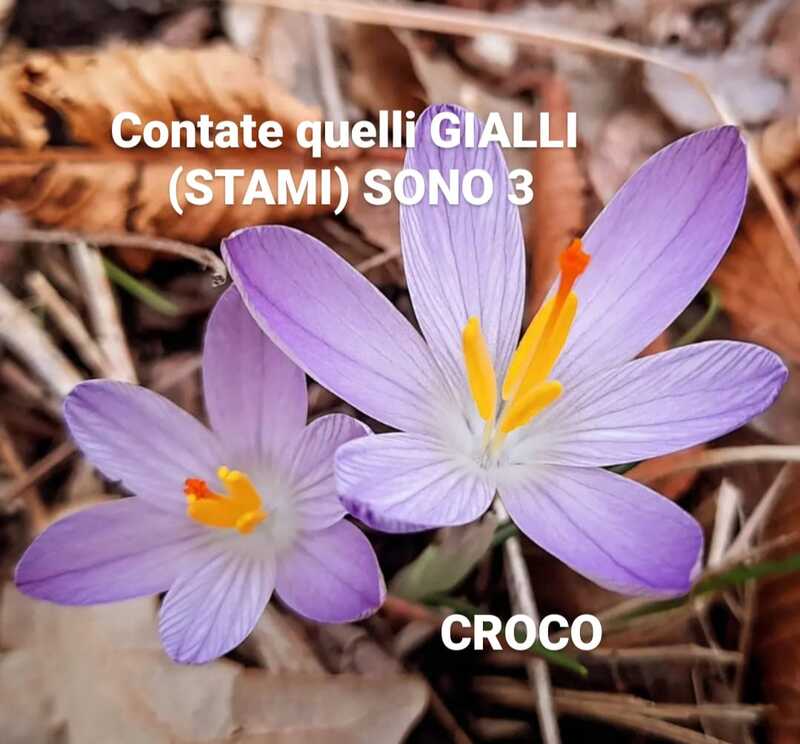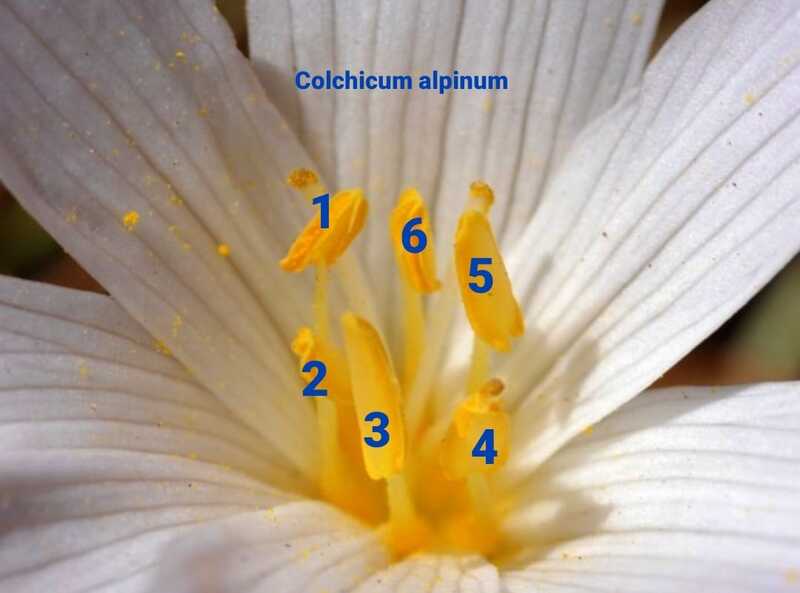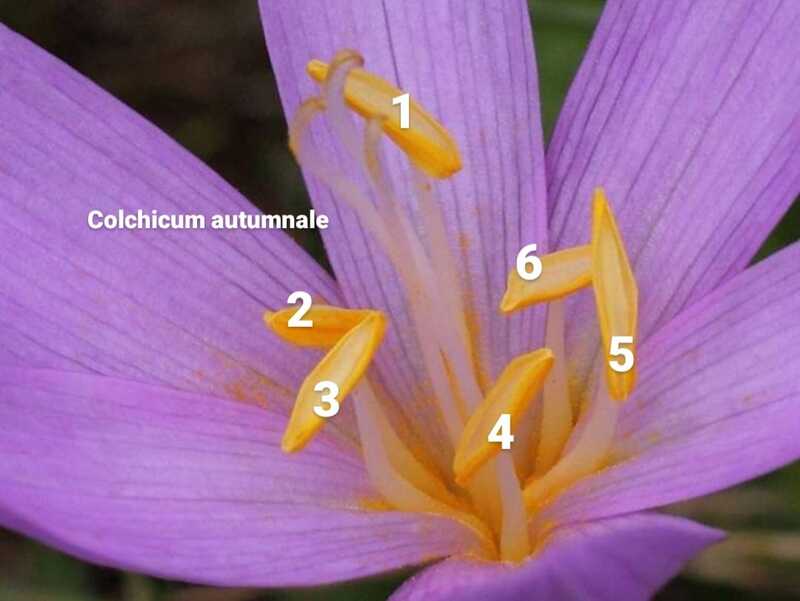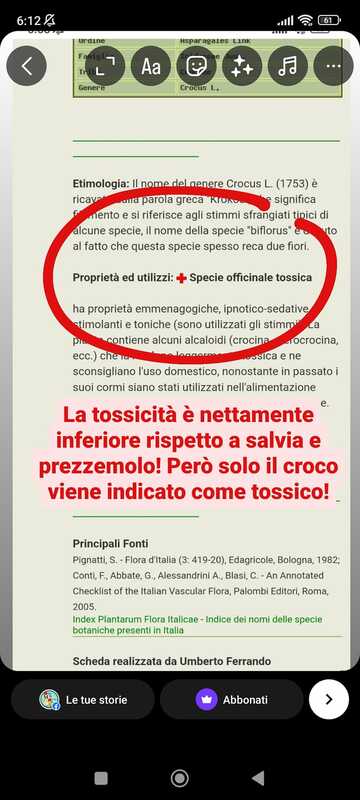Sfatiamo i miti: i Crocus non sono velenosi
Contenuto
Titolo
Sfatiamo i miti: i Crocus non sono velenosi
Descrizione
Mi tocca di nuovo chiarire la commestibilità di una specie che a torto è considerata velenosa.
Questa falsa credenza gira su internet! Addirittura su Wikipedia! E su Acta plantarum (dove però sono botanici e hanno lacune di etnobotanica e tossicologia e sarebbe molto meglio che si limitassero alla botanica onde evitare di creare confusioni fitoalimurgiche, ma vabbè). E non vi dico nei gruppi di erbe commestibili. Un delirio.
PUNTO 1: TUTTI I CROCUS SONO COMMESTIBILI.
RIPETIAMO: TUTTI I CROCUS SONO COMMESTIBILI.
PUNTO 2: LO ZAFFERANO È UN CROCUS
Il genere Crocus comprende circa 80 specie, di cui una trentina sono coltivate e 15 sono presenti nella flora spontanea italiana.
Il più pregiato è Crocus sativus L., lo zafferano, che ha un sapore eccezionale ed è ampiamente utilizzato in cucina e viene coltivato. Ma anche gli altri Crocus spontanei sono ASSOLUTAMENTE commestibili. Ovviamente il sapore NON ha niente a che vedere con quello di Crocus sativus L. ma io mi ricordo che da bambina, quando aiutavo a potare le viti in primavera, facevo scorpacciate di "cipolline" di màigole (nome bresciano per croco) e quindi è un sapore che amo e che mi ricorda l'infanzia.
Anche perché anche senza aver fatto nessun esame di genetica, chiedetevi: come è possibile che all'interno di un genere (Crocus) ce ne sia uno commestibile, anzi, più che commestibile, con millemila proprietà, cioè lo zafferano, Crocus sativus, e tutti gli altri no?! Non vi sembra un pelino strano?
PUNTO 3: tutti i Crucus hanno una dose tossica, come moltissime altre piante considerate commestibili. Nel caso dei Crocus la dose tossica, che vi provoca sintomi gastrointestinali, è di 1,5 g di stimmi (NON della restante parte della pianta) a persona (ci vogliono circa 150/160 fiori per fare un grammo di STIMMI) e la dose letale è 10 g di stimmi (NON della restante parte della pianta) a persona. L'unica parte della pianta che presenta tossicità accertata sono gli stimmi. Perché la tossicità è legata soprattutto alla presenza di safranale e di crocina che sono contenuti, in pratica, solo negli stimmi.
AL VOSTRO CORPO NON IMPORTA CHE SIA UN GRAMMO DI ZAFFERANO O DI QUALCHE ALTRO CROCUS MENO NOBILE.
Quindi sia che vogliate uccidervi con lo zafferano o con altro croco dovete mangiare 10 g di stimmi. Cioè dovete prendere gli stimmi di 1500 fiori. Con meno di 1500 fiori non morite. Tranquilli. L'ultima quotazione dello zafferano è 25€ al grammo quindi, con soli 250€, potete assicurarvi la morte.
E QUESTO NON LO DICO IO. Lo dice la letteratura medica! Non esiste un solo caso di morte per ingestione di Crocus! Ricordo che la tossicologia è una branca della farmacologia, e per diventare tossicologici ci vuole un percorso di laurea molto rigoroso. Non è che si può dire che una pianta è tossica o no, perché lo si è letto su internet o perché il cuggino vi ha detto così o perché avete raggiunto i 3000 punti Esselunga. La scienza non è un'opinione. Che vi piaccia o no. E se volete dire che una pianta è tossica dovete basarvi su studi ufficiali. Wikipedia NON rappresenta uno studio ufficiale e NEMMENO Acta plantarum, pur essendo fatti bene. PubMed sì. Per citare una banca dati di paper ufficiali. Ok? Anche sui libri ci possono essere scritte cose errate! O si citano le fonti ufficiali o non è detto che la cosa che leggete sia vera. Soprattutto quando si tratta di divulgazione scientifica, state sempre attenti che vengano riportate le fonti UFFICIALI. GRAZIE.
PUNTO 4: IL GROSSO PROBLEMA È CHE CONTINUATE A PENSARE CHE CROCUS EQUIVALGA A COLCHICO!
Il COLCHICO è assolutamente mortale. Ed è mortale a bassissime grammature. Basta un fiore! O una foglia! È la pianta che in assoluto fa più morti in Italia.
Crocus e Colchicum hanno l'aspetto simile ma sono profondamente diversi! NON SONO NEMMENO DELLA STESSA FAMIGLIA!
I Crocus sono della famiglia Iridaceae E HANNO 3 STAMI.
I Colchicum sono della famiglia Colchicaceae E HANNO 6 STAMI (unica eccezione Colchicum gonarei che ha solo 4 stami).
3 stami nei crochi e 6 nei colchico.
3 STAMI NEI CROCO E 6 NEI COLCHICO.
Non sono la stessa pianta. Non sono nemmeno della stessa famiglia!
Vi metto le foto.
Se volete smettere di fare confusione PER PIACERE usate la nomenclatura botanica. Perché solo il nome botanico (cioè in latino) è unico e univoco per ogni pianta. I nomi comuni o vernacolari indicano fino a 30 piante diverse CONTEMPORANEAMENTE. Quindi se mi dite "falso zafferano" potreste intendere sia il colchico che qualche croco che non è zafferano. Uno mortale e l'altro no.
PUNTO 5: mi spiegate perché nell'ultima settimana avete mangiato almeno una di queste piante potenzialmente mortali SENZA fare una piega: salvia, prezzemolo, spinacio, noce moscata, camomilla; ma se qualcuno posta la foto di un croco subito dovete dire che è velenoso?
Perché la camomilla la date ai neonati ma il croco è velenoso? Vi assicuro che anche Matricaria chamomilla lo è!
Perché il prezzemolo sì e la cicuta no? Sono mortali con lo stesso dosaggio, tra l'altro.
Perché gli spinaci sì e le romici no?
Perché la salvia è benefica ma l'artemisia no? La salvia contiene 10 volte le sostanze tossiche dell'artemisia. Giusto per.
Io capisco che quando si pensa alle cose ci agiscono le euristiche che ci fanno fare grossolani errori, ad esempio quella della rappresentatività o della disponibilità, però la tossicologia è una scienza esatta. Allora perché indicarmi su acta plantarum che la salvia è commestibile e il croco no? Ma la salvia volendo uccide a dosaggi nettamente inferiori! I grammi sono dati oggettivi, no? E degli scienziati dovrebbero essere oggettivi, no? Potete imparare a pensare in maniera oggettiva e non soggettiva? La vita diventa MOLTO più facile. Giuro.
PUNTO 6: se non siete sicuri non raccogliete e prima di raccogliere non affidatevi a foto o gruppi internet o alle maledette app! Fate i corsi con gli esperti! Ce ne sono in tutta Italia e veramente bravi! Noi ricominciamo con i corsi il 24 febbraio. Se non sapete a chi rivolgervi nella vostra zona chiedetemi. Ci sono decine di bravissimi professionisti! Che non vedono l'ora di sfatare i miti e farvi mangiare erbette buone!
BIBLIOGRAFIA: purtroppo ho potuto indicare solo 70 studi perché altrimenti esco dal numero di parole concesse su facebook. Ve li posso mandare in privato. Se non vi bastano 😉 sono centinaia.
Ps. La dose mortale indicata dagli studi sarebbe: LD50 4120±556 mg/kg, quindi varia, ovviamente, in base al peso della persona che ingerisce quel quantitativo di stimmi. Cioè va dai 10 g ai 20 g di stimmi.
Toxicology effects of saffron and its constituents: a review.
Hasan Badie Bostan, Soghra Mehri, and Hossein Hosseinzadeh.
https://www.ncbi.nlm.nih.gov/pmc/articles/PMC5339650/
Ahrazem O., Rubio-Moraga A., Nebauer S. G., Molina R. V., Gomez-Gomez L. Saffron: its phytochemistry, developmental processes, and biotechnological prospects. Journal of Agricultural and Food Chemistry
Fernández J. A., Santana O., Guardiola J. L., et al. The world saffron and Crocus collection: strategies for establishment, management, characterisation and utilisation. Genetic Resources and Crop Evolution
Dewan R. Bronze age flower power: the Minoan use and social significance of saffron and Crocus flowers. Chronica. 2015
Mohtashami L., Amiri M. S., Ramezani M., Emami S. A., Simal-Gandara J. The genus Crocus L.: A review of ethnobotanical uses, phytochemistry and pharmacology. Industrial Crops and Products . 2021
Bathaie S. Z., Mousavi S. Z. New applications and mechanisms of action of saffron and its important ingredients. Critical Reviews in Food Science and Nutrition . 2010
Deng Y., Guo Z. G., Zeng Z. L., Wang Z. Studies on the pharmacological effects of saffron (Crocus sativus L.)--a review. Zhongguo Zhong yao za zhi = Zhongguo zhongyao zazhi = China journal of Chinese materia medica . 2002
Bhargava B. K. Medicinal uses and pharmacological properties of Crocus sativus Linn (saffron) International Journal of Pharmacy and Pharmaceutical Sciences . 2011
Moghaddasi M. Saffron chemicals and medicine usage. Journal of Medicinal Plant Research: Planta Medica . 2010
Cid-Pérez T. S., Nevárez-Moorillón G. V., Ochoa-Velasco C. E., Navarro-Cruz A. R., Hernández-Carranza P., Avila-Sosa R. The relation between drying conditions and the development of volatile compounds in saffron (Crocus sativus) Molecules 2021
Zeka K., Ruparelia K. C., Continenza M. A., Stagos D., Veglio F., Arroo R. R. J. Petals of Crocus as a potential source of the antioxidants crocin and kaempferol. Fitoterapia 2015
Trapero A., Ahrazem O., Rubio-Moraga A., Jimeno M. L., Gomez M. D., Gomez-Gomez L. Characterization of a glucosyltransferase enzyme involved in the formation of kaempferol and quercetin sophorosides in Crocus. Plant Physiology 2012
Lamari F. N., Papasotiropoulos V., Tsiris D., et al. Phytochemical and genetic characterization of styles of wild Crocus species from the island of Crete, Greece and comparison to those of cultivated C. sativus. Fitoterapia . 2018
Mykhailenko O., Bezruk I., Ivanauskas L., Georgiyants V. Comparative analysis of apocarotenoids and phenolic constituents of Crocus sativus stigmas from 11 countries: ecological impact. Archiv der Pharmazie . 2022
Akhondzadeh S., Fallah-Pour H., Afkham K., Jamshidi A. H., Khalighi-Cigaroudi F. Comparison of Crocus sativus L. and imipramine in the treatment of mild to moderate depression: a pilot double-blind randomized trial [ISRCTN45683816] BMC Complementary and Alternative Medicine . 2004
Hosseinzadeh H., Talebzadeh F. Anticonvulsant evaluation of safranal and crocin from Crocus in mice. Fitoterapia . 2005
Hosseinzadeh H., Sadeghnia H. R. Protective effect of safranal on pentylenetetrazol-induced seizures in the rat: involvement of GABAergic and opioids systems. Phytomedicine.
2007
Hosseinzadeh H., Karimi G., Niapoor M. Antidepressant effect of Crocus sativus L. stigma extracts and their constituents, crocin and safranal, in mice. Acta Horticulturae . 2004
Plant List, T. http://www.theplantlist.org/
Heinrich M., Appendino G., Efferth T., et al. Best practice in research – overcoming common challenges in phytopharmacological research. Journal of Ethnopharmacology . 2020
Krishnan A. R., Mathew J., Salam S. A., Jiju V., Elessy A. A review on Crocus as an alternative therapy in medicine and dermatology. European Journal of Pharmaceutical and Medical Research . 2017
Sheidai M., Tabasi M., Mehrabian M., Koohdar F., Ghasemzadeh-Baraki S., Noormohammadi Z. Species delimitation and relationship in Crocus L. (Iridaceae) Acta Botanica Croatica . 2018
Aburjai T., Hudaib M., Tayyem R., Yousef M., Qishawi M. Ethnopharmacological survey of medicinal herbs in Jordan, the Ajloun Heights region. Journal of Ethnopharmacology . 2007
Asadi M. Antioxidant and antimicrobial activities in the different extracts of Caspian saffron, Crocus caspius Fisch & C. A. Mey. ex Hohen. Caspian Journal of Environmental Sciences. 2016
Demeter Z., Suranyi G., Molnar V. A., et al. Somatic embryogenesis and regeneration from shoot primordia of Crocus heuffelianus. Plant Cell, Tissue and Organ Culture. 2010
Jivad N., Zare-Hassanabadi N., Azizi M. Effect of combination of honey, saffron (Crocus sativus L.) and sedge (Cyperus rotundus L.) on cognitive dysfunction in patients with Alzheimer’s disease. Advanced Herbal Medicine. 2015
Pieroni A. Medicinal plants and food medicines in the folk traditions of the upper Lucca Province, Italy. Journal of Ethnopharmacology . 2000
Bilal A., Wani A. H., Khan A., Hamza R., Mohidin F. A. Saffron: a repository of medicinal properties. Journal of Medicinal Plant Research. 2011
Shah Z. A., Mir R., Matoo J. M., Dar M. A., Beigh M. A. Medicinal importance of saffron: a review. Journal of Pharmacognosy and Phytochemistry. 2017
Mousavi S. Z., Bathaie S. Z. Historical uses of saffron: identifying potential new avenues for modern research. Avicenna Journal of Phytomedicine. 2011
Hasan I., Ansari A. H., Sherwani A. M., Zulkifle M. The incredible health benefits of saffron: a review. Journal of Pharmacy Research. 2011
Rahmani A. H., Khan A. A., Aldebasi Y. H. Crocus and its active ingredients: role in the prevention and treatment of disease. Pharmacognosy Journal. 2017
D’Archivio A. A., Maggi M. A. Geographical identification of saffron (Crocus sativus L.) by linear discriminant analysis applied to the UV–visible spectra of aqueous extracts. Food Chemistry . 2017
Mashmoul M., Azlan A., Khaza'ai H., Yusof B. N., Noor S. M. Saffron: a natural potent antioxidant as a promising anti-obesity drug. Antioxidants. 2013
Bonet M. A., Valles J. Ethnobotany of Montseny biosphere reserve (Catalonia, Iberian Peninsula): plants used in veterinary medicine. Journal of Ethnopharmacology. 2007
Maggi L., Carmona M., Kelly S. D., Marigheto N., Alonso G. L. Geographical origin differentiation of saffron spice (Crocus sativus L. stigmas) - preliminary investigation using chemical and multi-element (H, C, N) stable isotope analysis. Food Chemistry. 2011
Tsimidou M., Tarantilis P. A. Special issue "Saffron (Crocus sativus L.): omics and other techniques in authenticity, quality, and Bioactivity Studies". Molecules. 2016
Rocchi R., Mascini M., Sergi M., Compagnone D., Mastrocola D., Pittia P. Crocins pattern in saffron detected by UHPLC-MS/MS as marker of quality, process and traceability. Food Chemistry. 2018
Patel S., Sarwat M., Khan T. H. Mechanism behind the anti-tumour potential of Crocus: the molecular perspective. Critical Reviews in Oncology/Hematology. 2017
Abdullaev F. I. Cancer chemopreventive and tumoricidal properties of saffron (Crocus sativus L.) Experimental Biology and Medicine (Maywood, N.J.) . 2002
Gohari A. R., Saeidnia S., Mahmoodabadi M. K. An overview on Crocus, phytochemicals, and medicinal properties. Pharmacognosy Reviews. 2013
Srivastava R., Ahmed H., Dixit R. K., Dharamveer, Saraf S. A. Crocus sativus L.: a comprehensive review. Pharmacognosy Reviews. 2010
Sánchez A. M., Carmona M., del Campo C. P., Alonso G. L. Solid-phase extraction for picrocrocin determination in the quality control of saffron spice (Crocus sativus L.) Food Chemistry. 2009
Garcia-Rodriguez M. V., Serrano-Diaz J., Tarantilis P. A., Lopez-Corcoles H., Carmona M., Alonso G. L. Determination of saffron quality by high-performance liquid chromatography. Journal of Agricultural and Food Chemistry. 2014
Assimopoulou A. N., Sinakos Z., Papageorgiou V. P. Radical scavenging activity of Crocus extract and its bioactive constituents. Phytotherapy research: PTR. 2005
Caballero-Ortega H., Pereda-Miranda R., Riverón-Negrete L., et al. Chemical composition of saffron (Crocus sativus L.) from four countries. Acta Horticulturae. 2004
Bouvier F., Suire C., Mutterer J., Camara B. Oxidative remodeling of chromoplast carotenoids: identification of the carotenoid dioxygenase CsCCD and CsZCD genes involved in Crocus secondary metabolite biogenesis. The Plant Cell. 2003
Moraga A. R., Nohales P. F., Perez J. A., Gomez-Gomez L. Glucosylation of the saffron apocarotenoid crocetin by a glucosyltransferase isolated from Crocus sativus stigmas. Planta. 2004
Winterhalter P., Straubinger M. Saffron-renewed interest in an ancient spice. Food Reviews International. 2000
Rajabi H., Ghorbani M., Jafari S. M., Sadeghi Mahoonak A., Rajabzadeh G. Retention of Crocus bioactive components by spray drying encapsulation using maltodextrin, gum Arabic and gelatin as wall materials. Food Hydrocolloids. 2015
Salehi B., Sestito S., Rapposelli S., et al. Epibatidine: a promising natural alkaloid in health. Biomolecules . 2019
Benkhaled A., Senator A., Boudjelal A., et al. Oral acute toxicity and red blood cytotoxicity of the medicinal halophyte Limoniastrum guyonianum leaf extract. Farmácia. 2020
Pasayeva L., Demirpolat E., Fatullayev H., Tugay O. Cytotoxic and phytochemical investigation of Cousinia ermenekensis Hub.-MOR. Farmácia. 2020
Das S. S., Alkahtani S., Bharadwaj P., et al. Molecular insights and novel approaches for targeting tumor metastasis. International Journal of Pharmaceutics. 2020
Sharifi-Rad J., Quispe C., Butnariu M., et al. Chitosan nanoparticles as a promising tool in nanomedicine with particular emphasis on oncological treatment. Cancer Cell International. 2021
Panigrahi B. K., Nayak A. K. Carbon nanotubes: an emerging drug delivery carrier in cancer therapeutics. Current Drug Delivery . 2020
Sharifi-Rad J., Quispe C., Patra J. K., et al. Paclitaxel: application in modern oncology and nanomedicine-based cancer therapy. Oxidative Medicine and Cellular Longevity . 2021
Samarghandian S., Borji A., Farahmand S. K., Afshari R., Davoodi S. Crocus stigma aqueous extract induces apoptosis in alveolar human lung cancer cells through caspase-dependent pathways activation. BioMed Research International. 2013
Vali F., Changizi V., Safa M. Synergistic apoptotic effect of crocin and paclitaxel or crocin and radiation on MCF-7 cells, a type of breast cancer cell line. International Journal of Breast Cancer. 2015
Mousavi M., Baharara J., Asadi-Samani M. Anti-angiogenesis effect of Crocous extract on matrix metalloproteinase gene activities in human breast carcinoma cells. Journal of HerbMed Pharmacology. 2014
Sun Y., Xu H. J., Zhao Y. X., et al. Crocin exhibits antitumor effects on human leukemia HL-60 cells in vitro and in vivo. Evidence-based Complementary and Alternative Medicine: Ecam. 2013
Zlatian O., Balasoiu A. T., Balasoiu M., et al. Antimicrobial resistance in bacterial pathogens among hospitalised patients with severe invasive infections. Experimental and Therapeutic Medicine. 2018
Ungureanu A., Zlatian O., Mitroi G., et al. Staphylococcus aureus colonisation in patients from a primary regional hospital. Molecular Medicine Reports. 2017
Muzaffar S., Rather S. A., Khan K. Z. In vitro bactericidal and fungicidal activities of various extracts of Crocus stigmas from Jammu & Kashmir, India. Cogent Food & Agriculture . 2016
Kakouri E., Daferera D., Paramithiotis S., Astraka K., Drosinos E. H., Polissiou M. G. Crocus tepals: the natural source of antioxidant and antimicrobial factors. Journal of Applied Research on Medicinal and Aromatic Plants . 2017
Mititelu R. R., Padureanu R., Bacanoiu M., et al. Inflammatory and oxidative stress markers-mirror tools in rheumatoid arthritis. Biomedicine. 2020
Padureanu R., Albu C. V., Mititelu R. R., et al. Oxidative stress and inflammation interdependence in multiple sclerosis. Journal of Clinical Medicine. 2019
Chen Y., Zhang H., Tian X., et al. Antioxidant potential of crocins and ethanol extracts of Gardenia jasminoides ELLIS and Crocus: a relationship investigation between antioxidant activity and crocin contents. Food Chemistry . 2008
https://phytochem.nal.usda.gov/
© Copyright Associazione capra&cavoli, condividi non copiare. Grazie
Questa falsa credenza gira su internet! Addirittura su Wikipedia! E su Acta plantarum (dove però sono botanici e hanno lacune di etnobotanica e tossicologia e sarebbe molto meglio che si limitassero alla botanica onde evitare di creare confusioni fitoalimurgiche, ma vabbè). E non vi dico nei gruppi di erbe commestibili. Un delirio.
PUNTO 1: TUTTI I CROCUS SONO COMMESTIBILI.
RIPETIAMO: TUTTI I CROCUS SONO COMMESTIBILI.
PUNTO 2: LO ZAFFERANO È UN CROCUS
Il genere Crocus comprende circa 80 specie, di cui una trentina sono coltivate e 15 sono presenti nella flora spontanea italiana.
Il più pregiato è Crocus sativus L., lo zafferano, che ha un sapore eccezionale ed è ampiamente utilizzato in cucina e viene coltivato. Ma anche gli altri Crocus spontanei sono ASSOLUTAMENTE commestibili. Ovviamente il sapore NON ha niente a che vedere con quello di Crocus sativus L. ma io mi ricordo che da bambina, quando aiutavo a potare le viti in primavera, facevo scorpacciate di "cipolline" di màigole (nome bresciano per croco) e quindi è un sapore che amo e che mi ricorda l'infanzia.
Anche perché anche senza aver fatto nessun esame di genetica, chiedetevi: come è possibile che all'interno di un genere (Crocus) ce ne sia uno commestibile, anzi, più che commestibile, con millemila proprietà, cioè lo zafferano, Crocus sativus, e tutti gli altri no?! Non vi sembra un pelino strano?
PUNTO 3: tutti i Crucus hanno una dose tossica, come moltissime altre piante considerate commestibili. Nel caso dei Crocus la dose tossica, che vi provoca sintomi gastrointestinali, è di 1,5 g di stimmi (NON della restante parte della pianta) a persona (ci vogliono circa 150/160 fiori per fare un grammo di STIMMI) e la dose letale è 10 g di stimmi (NON della restante parte della pianta) a persona. L'unica parte della pianta che presenta tossicità accertata sono gli stimmi. Perché la tossicità è legata soprattutto alla presenza di safranale e di crocina che sono contenuti, in pratica, solo negli stimmi.
AL VOSTRO CORPO NON IMPORTA CHE SIA UN GRAMMO DI ZAFFERANO O DI QUALCHE ALTRO CROCUS MENO NOBILE.
Quindi sia che vogliate uccidervi con lo zafferano o con altro croco dovete mangiare 10 g di stimmi. Cioè dovete prendere gli stimmi di 1500 fiori. Con meno di 1500 fiori non morite. Tranquilli. L'ultima quotazione dello zafferano è 25€ al grammo quindi, con soli 250€, potete assicurarvi la morte.
E QUESTO NON LO DICO IO. Lo dice la letteratura medica! Non esiste un solo caso di morte per ingestione di Crocus! Ricordo che la tossicologia è una branca della farmacologia, e per diventare tossicologici ci vuole un percorso di laurea molto rigoroso. Non è che si può dire che una pianta è tossica o no, perché lo si è letto su internet o perché il cuggino vi ha detto così o perché avete raggiunto i 3000 punti Esselunga. La scienza non è un'opinione. Che vi piaccia o no. E se volete dire che una pianta è tossica dovete basarvi su studi ufficiali. Wikipedia NON rappresenta uno studio ufficiale e NEMMENO Acta plantarum, pur essendo fatti bene. PubMed sì. Per citare una banca dati di paper ufficiali. Ok? Anche sui libri ci possono essere scritte cose errate! O si citano le fonti ufficiali o non è detto che la cosa che leggete sia vera. Soprattutto quando si tratta di divulgazione scientifica, state sempre attenti che vengano riportate le fonti UFFICIALI. GRAZIE.
PUNTO 4: IL GROSSO PROBLEMA È CHE CONTINUATE A PENSARE CHE CROCUS EQUIVALGA A COLCHICO!
Il COLCHICO è assolutamente mortale. Ed è mortale a bassissime grammature. Basta un fiore! O una foglia! È la pianta che in assoluto fa più morti in Italia.
Crocus e Colchicum hanno l'aspetto simile ma sono profondamente diversi! NON SONO NEMMENO DELLA STESSA FAMIGLIA!
I Crocus sono della famiglia Iridaceae E HANNO 3 STAMI.
I Colchicum sono della famiglia Colchicaceae E HANNO 6 STAMI (unica eccezione Colchicum gonarei che ha solo 4 stami).
3 stami nei crochi e 6 nei colchico.
3 STAMI NEI CROCO E 6 NEI COLCHICO.
Non sono la stessa pianta. Non sono nemmeno della stessa famiglia!
Vi metto le foto.
Se volete smettere di fare confusione PER PIACERE usate la nomenclatura botanica. Perché solo il nome botanico (cioè in latino) è unico e univoco per ogni pianta. I nomi comuni o vernacolari indicano fino a 30 piante diverse CONTEMPORANEAMENTE. Quindi se mi dite "falso zafferano" potreste intendere sia il colchico che qualche croco che non è zafferano. Uno mortale e l'altro no.
PUNTO 5: mi spiegate perché nell'ultima settimana avete mangiato almeno una di queste piante potenzialmente mortali SENZA fare una piega: salvia, prezzemolo, spinacio, noce moscata, camomilla; ma se qualcuno posta la foto di un croco subito dovete dire che è velenoso?
Perché la camomilla la date ai neonati ma il croco è velenoso? Vi assicuro che anche Matricaria chamomilla lo è!
Perché il prezzemolo sì e la cicuta no? Sono mortali con lo stesso dosaggio, tra l'altro.
Perché gli spinaci sì e le romici no?
Perché la salvia è benefica ma l'artemisia no? La salvia contiene 10 volte le sostanze tossiche dell'artemisia. Giusto per.
Io capisco che quando si pensa alle cose ci agiscono le euristiche che ci fanno fare grossolani errori, ad esempio quella della rappresentatività o della disponibilità, però la tossicologia è una scienza esatta. Allora perché indicarmi su acta plantarum che la salvia è commestibile e il croco no? Ma la salvia volendo uccide a dosaggi nettamente inferiori! I grammi sono dati oggettivi, no? E degli scienziati dovrebbero essere oggettivi, no? Potete imparare a pensare in maniera oggettiva e non soggettiva? La vita diventa MOLTO più facile. Giuro.
PUNTO 6: se non siete sicuri non raccogliete e prima di raccogliere non affidatevi a foto o gruppi internet o alle maledette app! Fate i corsi con gli esperti! Ce ne sono in tutta Italia e veramente bravi! Noi ricominciamo con i corsi il 24 febbraio. Se non sapete a chi rivolgervi nella vostra zona chiedetemi. Ci sono decine di bravissimi professionisti! Che non vedono l'ora di sfatare i miti e farvi mangiare erbette buone!
BIBLIOGRAFIA: purtroppo ho potuto indicare solo 70 studi perché altrimenti esco dal numero di parole concesse su facebook. Ve li posso mandare in privato. Se non vi bastano 😉 sono centinaia.
Ps. La dose mortale indicata dagli studi sarebbe: LD50 4120±556 mg/kg, quindi varia, ovviamente, in base al peso della persona che ingerisce quel quantitativo di stimmi. Cioè va dai 10 g ai 20 g di stimmi.
Toxicology effects of saffron and its constituents: a review.
Hasan Badie Bostan, Soghra Mehri, and Hossein Hosseinzadeh.
https://www.ncbi.nlm.nih.gov/pmc/articles/PMC5339650/
Ahrazem O., Rubio-Moraga A., Nebauer S. G., Molina R. V., Gomez-Gomez L. Saffron: its phytochemistry, developmental processes, and biotechnological prospects. Journal of Agricultural and Food Chemistry
Fernández J. A., Santana O., Guardiola J. L., et al. The world saffron and Crocus collection: strategies for establishment, management, characterisation and utilisation. Genetic Resources and Crop Evolution
Dewan R. Bronze age flower power: the Minoan use and social significance of saffron and Crocus flowers. Chronica. 2015
Mohtashami L., Amiri M. S., Ramezani M., Emami S. A., Simal-Gandara J. The genus Crocus L.: A review of ethnobotanical uses, phytochemistry and pharmacology. Industrial Crops and Products . 2021
Bathaie S. Z., Mousavi S. Z. New applications and mechanisms of action of saffron and its important ingredients. Critical Reviews in Food Science and Nutrition . 2010
Deng Y., Guo Z. G., Zeng Z. L., Wang Z. Studies on the pharmacological effects of saffron (Crocus sativus L.)--a review. Zhongguo Zhong yao za zhi = Zhongguo zhongyao zazhi = China journal of Chinese materia medica . 2002
Bhargava B. K. Medicinal uses and pharmacological properties of Crocus sativus Linn (saffron) International Journal of Pharmacy and Pharmaceutical Sciences . 2011
Moghaddasi M. Saffron chemicals and medicine usage. Journal of Medicinal Plant Research: Planta Medica . 2010
Cid-Pérez T. S., Nevárez-Moorillón G. V., Ochoa-Velasco C. E., Navarro-Cruz A. R., Hernández-Carranza P., Avila-Sosa R. The relation between drying conditions and the development of volatile compounds in saffron (Crocus sativus) Molecules 2021
Zeka K., Ruparelia K. C., Continenza M. A., Stagos D., Veglio F., Arroo R. R. J. Petals of Crocus as a potential source of the antioxidants crocin and kaempferol. Fitoterapia 2015
Trapero A., Ahrazem O., Rubio-Moraga A., Jimeno M. L., Gomez M. D., Gomez-Gomez L. Characterization of a glucosyltransferase enzyme involved in the formation of kaempferol and quercetin sophorosides in Crocus. Plant Physiology 2012
Lamari F. N., Papasotiropoulos V., Tsiris D., et al. Phytochemical and genetic characterization of styles of wild Crocus species from the island of Crete, Greece and comparison to those of cultivated C. sativus. Fitoterapia . 2018
Mykhailenko O., Bezruk I., Ivanauskas L., Georgiyants V. Comparative analysis of apocarotenoids and phenolic constituents of Crocus sativus stigmas from 11 countries: ecological impact. Archiv der Pharmazie . 2022
Akhondzadeh S., Fallah-Pour H., Afkham K., Jamshidi A. H., Khalighi-Cigaroudi F. Comparison of Crocus sativus L. and imipramine in the treatment of mild to moderate depression: a pilot double-blind randomized trial [ISRCTN45683816] BMC Complementary and Alternative Medicine . 2004
Hosseinzadeh H., Talebzadeh F. Anticonvulsant evaluation of safranal and crocin from Crocus in mice. Fitoterapia . 2005
Hosseinzadeh H., Sadeghnia H. R. Protective effect of safranal on pentylenetetrazol-induced seizures in the rat: involvement of GABAergic and opioids systems. Phytomedicine.
2007
Hosseinzadeh H., Karimi G., Niapoor M. Antidepressant effect of Crocus sativus L. stigma extracts and their constituents, crocin and safranal, in mice. Acta Horticulturae . 2004
Plant List, T. http://www.theplantlist.org/
Heinrich M., Appendino G., Efferth T., et al. Best practice in research – overcoming common challenges in phytopharmacological research. Journal of Ethnopharmacology . 2020
Krishnan A. R., Mathew J., Salam S. A., Jiju V., Elessy A. A review on Crocus as an alternative therapy in medicine and dermatology. European Journal of Pharmaceutical and Medical Research . 2017
Sheidai M., Tabasi M., Mehrabian M., Koohdar F., Ghasemzadeh-Baraki S., Noormohammadi Z. Species delimitation and relationship in Crocus L. (Iridaceae) Acta Botanica Croatica . 2018
Aburjai T., Hudaib M., Tayyem R., Yousef M., Qishawi M. Ethnopharmacological survey of medicinal herbs in Jordan, the Ajloun Heights region. Journal of Ethnopharmacology . 2007
Asadi M. Antioxidant and antimicrobial activities in the different extracts of Caspian saffron, Crocus caspius Fisch & C. A. Mey. ex Hohen. Caspian Journal of Environmental Sciences. 2016
Demeter Z., Suranyi G., Molnar V. A., et al. Somatic embryogenesis and regeneration from shoot primordia of Crocus heuffelianus. Plant Cell, Tissue and Organ Culture. 2010
Jivad N., Zare-Hassanabadi N., Azizi M. Effect of combination of honey, saffron (Crocus sativus L.) and sedge (Cyperus rotundus L.) on cognitive dysfunction in patients with Alzheimer’s disease. Advanced Herbal Medicine. 2015
Pieroni A. Medicinal plants and food medicines in the folk traditions of the upper Lucca Province, Italy. Journal of Ethnopharmacology . 2000
Bilal A., Wani A. H., Khan A., Hamza R., Mohidin F. A. Saffron: a repository of medicinal properties. Journal of Medicinal Plant Research. 2011
Shah Z. A., Mir R., Matoo J. M., Dar M. A., Beigh M. A. Medicinal importance of saffron: a review. Journal of Pharmacognosy and Phytochemistry. 2017
Mousavi S. Z., Bathaie S. Z. Historical uses of saffron: identifying potential new avenues for modern research. Avicenna Journal of Phytomedicine. 2011
Hasan I., Ansari A. H., Sherwani A. M., Zulkifle M. The incredible health benefits of saffron: a review. Journal of Pharmacy Research. 2011
Rahmani A. H., Khan A. A., Aldebasi Y. H. Crocus and its active ingredients: role in the prevention and treatment of disease. Pharmacognosy Journal. 2017
D’Archivio A. A., Maggi M. A. Geographical identification of saffron (Crocus sativus L.) by linear discriminant analysis applied to the UV–visible spectra of aqueous extracts. Food Chemistry . 2017
Mashmoul M., Azlan A., Khaza'ai H., Yusof B. N., Noor S. M. Saffron: a natural potent antioxidant as a promising anti-obesity drug. Antioxidants. 2013
Bonet M. A., Valles J. Ethnobotany of Montseny biosphere reserve (Catalonia, Iberian Peninsula): plants used in veterinary medicine. Journal of Ethnopharmacology. 2007
Maggi L., Carmona M., Kelly S. D., Marigheto N., Alonso G. L. Geographical origin differentiation of saffron spice (Crocus sativus L. stigmas) - preliminary investigation using chemical and multi-element (H, C, N) stable isotope analysis. Food Chemistry. 2011
Tsimidou M., Tarantilis P. A. Special issue "Saffron (Crocus sativus L.): omics and other techniques in authenticity, quality, and Bioactivity Studies". Molecules. 2016
Rocchi R., Mascini M., Sergi M., Compagnone D., Mastrocola D., Pittia P. Crocins pattern in saffron detected by UHPLC-MS/MS as marker of quality, process and traceability. Food Chemistry. 2018
Patel S., Sarwat M., Khan T. H. Mechanism behind the anti-tumour potential of Crocus: the molecular perspective. Critical Reviews in Oncology/Hematology. 2017
Abdullaev F. I. Cancer chemopreventive and tumoricidal properties of saffron (Crocus sativus L.) Experimental Biology and Medicine (Maywood, N.J.) . 2002
Gohari A. R., Saeidnia S., Mahmoodabadi M. K. An overview on Crocus, phytochemicals, and medicinal properties. Pharmacognosy Reviews. 2013
Srivastava R., Ahmed H., Dixit R. K., Dharamveer, Saraf S. A. Crocus sativus L.: a comprehensive review. Pharmacognosy Reviews. 2010
Sánchez A. M., Carmona M., del Campo C. P., Alonso G. L. Solid-phase extraction for picrocrocin determination in the quality control of saffron spice (Crocus sativus L.) Food Chemistry. 2009
Garcia-Rodriguez M. V., Serrano-Diaz J., Tarantilis P. A., Lopez-Corcoles H., Carmona M., Alonso G. L. Determination of saffron quality by high-performance liquid chromatography. Journal of Agricultural and Food Chemistry. 2014
Assimopoulou A. N., Sinakos Z., Papageorgiou V. P. Radical scavenging activity of Crocus extract and its bioactive constituents. Phytotherapy research: PTR. 2005
Caballero-Ortega H., Pereda-Miranda R., Riverón-Negrete L., et al. Chemical composition of saffron (Crocus sativus L.) from four countries. Acta Horticulturae. 2004
Bouvier F., Suire C., Mutterer J., Camara B. Oxidative remodeling of chromoplast carotenoids: identification of the carotenoid dioxygenase CsCCD and CsZCD genes involved in Crocus secondary metabolite biogenesis. The Plant Cell. 2003
Moraga A. R., Nohales P. F., Perez J. A., Gomez-Gomez L. Glucosylation of the saffron apocarotenoid crocetin by a glucosyltransferase isolated from Crocus sativus stigmas. Planta. 2004
Winterhalter P., Straubinger M. Saffron-renewed interest in an ancient spice. Food Reviews International. 2000
Rajabi H., Ghorbani M., Jafari S. M., Sadeghi Mahoonak A., Rajabzadeh G. Retention of Crocus bioactive components by spray drying encapsulation using maltodextrin, gum Arabic and gelatin as wall materials. Food Hydrocolloids. 2015
Salehi B., Sestito S., Rapposelli S., et al. Epibatidine: a promising natural alkaloid in health. Biomolecules . 2019
Benkhaled A., Senator A., Boudjelal A., et al. Oral acute toxicity and red blood cytotoxicity of the medicinal halophyte Limoniastrum guyonianum leaf extract. Farmácia. 2020
Pasayeva L., Demirpolat E., Fatullayev H., Tugay O. Cytotoxic and phytochemical investigation of Cousinia ermenekensis Hub.-MOR. Farmácia. 2020
Das S. S., Alkahtani S., Bharadwaj P., et al. Molecular insights and novel approaches for targeting tumor metastasis. International Journal of Pharmaceutics. 2020
Sharifi-Rad J., Quispe C., Butnariu M., et al. Chitosan nanoparticles as a promising tool in nanomedicine with particular emphasis on oncological treatment. Cancer Cell International. 2021
Panigrahi B. K., Nayak A. K. Carbon nanotubes: an emerging drug delivery carrier in cancer therapeutics. Current Drug Delivery . 2020
Sharifi-Rad J., Quispe C., Patra J. K., et al. Paclitaxel: application in modern oncology and nanomedicine-based cancer therapy. Oxidative Medicine and Cellular Longevity . 2021
Samarghandian S., Borji A., Farahmand S. K., Afshari R., Davoodi S. Crocus stigma aqueous extract induces apoptosis in alveolar human lung cancer cells through caspase-dependent pathways activation. BioMed Research International. 2013
Vali F., Changizi V., Safa M. Synergistic apoptotic effect of crocin and paclitaxel or crocin and radiation on MCF-7 cells, a type of breast cancer cell line. International Journal of Breast Cancer. 2015
Mousavi M., Baharara J., Asadi-Samani M. Anti-angiogenesis effect of Crocous extract on matrix metalloproteinase gene activities in human breast carcinoma cells. Journal of HerbMed Pharmacology. 2014
Sun Y., Xu H. J., Zhao Y. X., et al. Crocin exhibits antitumor effects on human leukemia HL-60 cells in vitro and in vivo. Evidence-based Complementary and Alternative Medicine: Ecam. 2013
Zlatian O., Balasoiu A. T., Balasoiu M., et al. Antimicrobial resistance in bacterial pathogens among hospitalised patients with severe invasive infections. Experimental and Therapeutic Medicine. 2018
Ungureanu A., Zlatian O., Mitroi G., et al. Staphylococcus aureus colonisation in patients from a primary regional hospital. Molecular Medicine Reports. 2017
Muzaffar S., Rather S. A., Khan K. Z. In vitro bactericidal and fungicidal activities of various extracts of Crocus stigmas from Jammu & Kashmir, India. Cogent Food & Agriculture . 2016
Kakouri E., Daferera D., Paramithiotis S., Astraka K., Drosinos E. H., Polissiou M. G. Crocus tepals: the natural source of antioxidant and antimicrobial factors. Journal of Applied Research on Medicinal and Aromatic Plants . 2017
Mititelu R. R., Padureanu R., Bacanoiu M., et al. Inflammatory and oxidative stress markers-mirror tools in rheumatoid arthritis. Biomedicine. 2020
Padureanu R., Albu C. V., Mititelu R. R., et al. Oxidative stress and inflammation interdependence in multiple sclerosis. Journal of Clinical Medicine. 2019
Chen Y., Zhang H., Tian X., et al. Antioxidant potential of crocins and ethanol extracts of Gardenia jasminoides ELLIS and Crocus: a relationship investigation between antioxidant activity and crocin contents. Food Chemistry . 2008
https://phytochem.nal.usda.gov/
© Copyright Associazione capra&cavoli, condividi non copiare. Grazie


